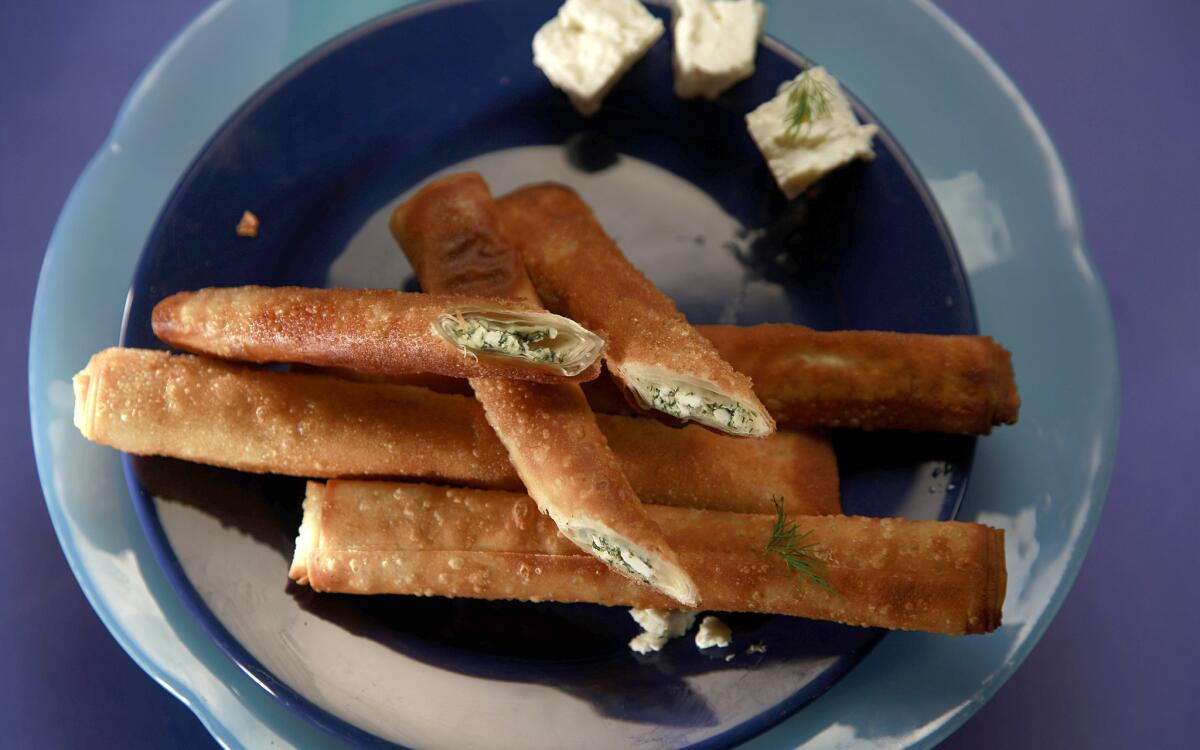Cheese cigars

Indulging in fried foods is traditional during the eight days of Hanukkah, which begins this year on the evening of Dec. 24 and concludes on Jan. 1.
That’s because the customs of the Festival of Lights commemorate the miracle of the oil, said to have taken place in Jerusalem in the second century BC; the story goes that one day’s worth of ritually pure oil for rekindling the Holy Temple’s eternal light lasted for eight days. Since olive oil was the oil available in ancient Israel, some use it during the holiday for frying and for lighting menorahs.
For our Hanukkah menus, we prepare fried appetizers using ingredients from the lands of the Bible.
From bulgur wheat, a staple in the eastern Mediterranean for millenniums, we make fried mini bulgur meatballs like those we tasted at the Bulgur Festival in Turkey’s gastronomic capital, Gaziantep, near Syria. These meatballs, which are flavored with semi-hot red pepper, onion and garlic, are cooked by a special technique — first they’re steamed, then sautéed in olive oil. The bulgur contributes a delicate crunch to these bite-size treats.
In southeastern Turkey, people make a variety of such meatballs, from egg-sized to some as tiny as garbanzo beans. Gaziantep culinary expert Filiz Hösükoğlu told us that the minuscule balls are made only on special occasions, when mothers want to reward their children for being good.
Potato latkes were not on the menu in ancient Israel, as spuds were not known in the Old World. People might have made latkes from lentils, the star ingredient in Esau’s famous pottage in the Book of Genesis. Our hearty Turkish lentil latkes gain a pleasing crust from bulgur and are easier to make than potato latkes because you don’t need to shred potatoes. We serve them with a creamy topping — yogurt sauce with chard and garlic.
Dairy foods were central to the diet of the Land of Milk and Honey, and we use cheese in two Hanukkah appetizers. One is cheese cigars, also called cheese rolls or cheese boreks. This favorite Turkish mezze item, which is made of crisp pastry with cheese filling, makes a fun finger food for the holiday. You need only four ingredients to prepare them — filo dough, feta cheese, fresh dill and oil for frying.
Feta cheese also flavors our zucchini latkes, which are popular throughout Turkey. In Israel, people whose families emigrated from Turkey, Syria or Greece make these pancakes dairy-free if they plan to eat them at a kosher meal that includes meat.
Just in case someone might miss potato latkes at a Hanukkah celebration, you can serve them together with the zucchini latkes. The yogurt-dill-garlic topping is delicious with both kinds of pancakes.
With Hanukkah beginning on Christmas Eve this year and with many families celebrating both holidays that night, these appetizers can do double duty. After all, the Christmas story took place in the same land as the Hanukkah story, and everyone there feasted on Middle Eastern foods.
Faye Levy is the author of “Feast From the Mideast” and “1,000 Jewish Recipes.”
If the dough sheets are frozen, thaw them in the refrigerator 8 hours or overnight, or according to package instructions. Set the dough sheets aside to come to room temperature in their package; this takes about 2 hours.
To make the filling, mash and crumble the feta cheese with a fork in a bowl until it is finely crumbled. Add the dill and pepper and mix well.
Prepare a small bowl of water to moisten the dough. Unroll the dough sheets onto a cutting board. With a sharp knife, cut the stack of dough sheets in half crosswise, to get sheets that are about 8 inches wide. Immediately cover the sheets with plastic wrap, then with a slightly damp towel. Work with only 1 piece at a time, keeping the remaining sheets covered so they do not dry out.
To make a cigar, remove one piece of borek from the pile to a work surface, the shorter side of the rectangle facing you (“vertical” orientation). Spoon 1 tablespoon filling in a thin strip about 1 inch from the bottom edge, leaving about 1 inch clear on each end. Fold the bottom edge of dough over the filling, press so the filling is fairly tightly enclosed, and roll the dough over the filling again. Fold the two long sides of the filo, to your left and right, inward slightly over the filling, and press gently on these folds. Roll the pastry up fairly tightly in a finger shape. Before you finish rolling, dip your finger in water and moisten the end to stick the dough together. Press to adhere.
Set the pastry cigar on a plate. Cover with plastic wrap. Shape more cigars with the remaining dough and filling.
Heat a thin film of oil in a deep skillet. It should be hot enough so it sizzles when you dip the end of a pastry cigar in it. Fry 4 or 5 cigars at time over medium heat until golden, about 1 minute on each side. Remove to paper towels. Serve hot or warm.
Get our Cooking newsletter.
Your roundup of inspiring recipes and kitchen tricks.
You may occasionally receive promotional content from the Los Angeles Times.














